
As a parent, you want the best care for your child—especially when it comes to their health and smile. So, when your dentist recommends a stainless steel crown (SSC) for your child’s tooth, it’s only natural to have questions.
In this article, we’ll explore what a stainless steel crown is, when it’s needed, its benefits, and address 15 of the most commonly asked questions by parents.
10 Common question about Stainless Steel Crown(FAQs)
- Are stainless steel crowns safe?
Yes. They are biocompatible and widely used across the globe. - Will the crown fall off?
Rarely. If it does, bring it to your dentist immediately. - Is the Hall Technique painful?
No. It’s pain-free, as there’s no drilling or injections. - Can decay continue under the crown?
No. Once sealed, bacteria can’t thrive. - How long will the crown last?
Usually until the baby tooth falls out. - Can crowns be placed on front teeth?
SSCs are mainly for back molars. White crowns are an option for front teeth. - What if my child swallows the crown?
This is very rare. In such cases, monitor and contact your dentist. - What if I don’t treat the decayed tooth?
It can lead to pain, infection, or early tooth loss. - Is the crown removed later?
No, it naturally comes out with the baby tooth. - Can SSCs be reused?
No. Each crown is single-use.
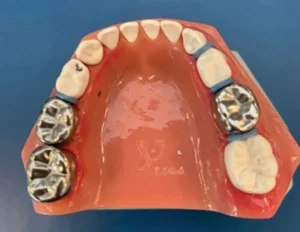
What Is a Stainless Steel Crown?
A stainless steel crown is a pre-formed metal cap that is used to restore and protect a damaged or decayed tooth. These crowns are commonly used in paediatric dentistry for primary (baby) teeth that are too badly decayed or fractured for a regular filling.
Unlike adult crowns (which may be porcelain or ceramic), stainless steel crowns are durable, affordable, and quick to place — making them ideal for children.
When Is a Stainless Steel Crown Recommended?
A dentist may suggest a Stainless Steel Crown (SSC) for a child in the following situations:
- There is extensive tooth decay that can’t be fixed with a regular filling.
- The child had a pulpotomy or pulpectomy (baby tooth root canal treatment).
- A Class II cavity is present — decay that extends to the surfaces between teeth and may not hold a normal filling well.
- The tooth has early decay, especially in children with a high risk of cavities.
- A previous filling has failed multiple times.
- The tooth is fractured due to trauma or strong biting forces.
- The child has early childhood caries (multiple decayed baby teeth).
- The tooth needs to be preserved to maintain space until it naturally falls out.
In many cases, an SSC can save a tooth that might otherwise need to be extracted — especially when long-term durability and protection are important.
Why Save a Baby Tooth?
Some parents wonder—“Why not just pull the baby tooth?”
Here’s why it’s usually better to save the tooth with a crown:
- Baby teeth help maintain space for permanent teeth.
- They are important for chewing, speech development, and self-esteem.
- Early loss of baby teeth can lead to misalignment of adult teeth.
- Removing a baby tooth too soon may require a space maintainer later.
What Does the Crown Look Like?
- Stainless steel crowns have a silver, shiny appearance, which is noticeable—especially if placed on a front tooth. However, they are mostly used for back teeth, where aesthetics are less of a concern.
- Some parents opt for tooth-coloured crowns for front teeth, but those are more expensive and not as durable.
Benefits of Stainless Steel Crowns
- ✅ Strong and long-lasting
- ✅ Resistant to further decay
- ✅ Protects the entire tooth
- ✅ Cost-effective
- ✅ Ideal for children who may not sit through longer procedures
- ✅ No need for multiple appointments
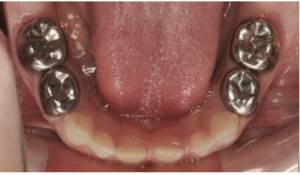
What Is the Hall Technique?
The Hall Technique is a modern, drill-free, injection-free method of placing a stainless steel crown. It involves placing the crown without removing the decay. Instead, the crown is sealed over the tooth, cutting off the bacteria’s access to oxygen and nutrients.
Benefits of the Hall Technique:
- No local anesthesia
- No drilling or removal of tooth structure
- Quicker appointments (15–20 minutes)
- High success rate
What Happens During the Procedure?
Hall Technique (Step-by-Step)
The Hall Technique is a minimally invasive method that avoids injections, drilling, or tooth preparation. It is suitable for early to moderate decay in primary molars and is particularly helpful for anxious children.
Appointment 1: Initial Consultation
- Dentist examines the decayed tooth and takes X-rays if necessary.
- Hall Technique is explained to parents.
- Suitable teeth are identified for treatment.
- Orthodontic separators (small elastic bands) may be placed between the teeth to create space for the crown
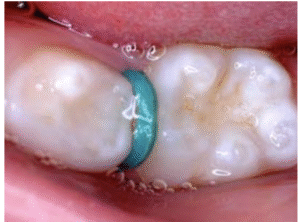
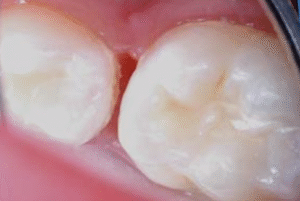
Appointment 2: Crown Placement ( 2-5 days after separator is placed)
- Separators are removed.
- A pre-formed stainless steel crown is selected and adjusted for proper fit.
- The crown is filled with dental cement.
- The crown is pressed gently onto the tooth until it clicks into place.
- Bite is checked to ensure proper alignment.
Benefit of Hall’s technique
- No injection or drilling is needed.
- The decay is sealed inside, stopping its progression.
- Most children adapt quickly to the crown.
Follow-Up Care
- The child may feel slight pressure for a day or two.
- Normal brushing and flossing should continue.
- A review is usually scheduled in 6–12 months to monitor the crown and the surrounding teeth.
Are Stainless steel crown Any Side Effects?
Stainless steel crowns are considered very safe, but in rare cases, some children may experience:
- Minor discomfort for a day or two after placement
- Mild irritation of surrounding gum tissue
- Very rare allergic reaction to nickel (if sensitive)
Most children adjust to the crown quickly and have no long-term issues.
Caring for a Tooth with a Crown
You don’t need to do anything special. Just maintain good oral hygiene:
- Brush twice a day with fluoride toothpaste
- Floss daily (especially around the crown)
- Avoid sticky, hard candy that can loosen the crown
- Visit the dentist every 6 months
Will the Stainless Steel Crown Fall Out?
Stainless steel crowns are known for their durability and retention, and they rarely fall off when placed correctly. However, in some cases, dislodgement can occur due to the following reasons:
- Poor initial fit or incorrect cementation.
- Child chewing on sticky foods (e.g., gum, toffee) during the first 24–48 hours after placement.
- Natural tooth eruption and exfoliation forces.
- Underlying tooth structure breaking down over time
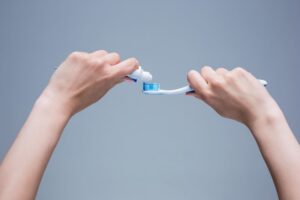
Probability and Outcomes:
- Studies suggest that the success rate of SSCs is over 90–95% over several years.
- The Hall Technique has a similar high retention rate, especially when proper case selection and technique are followed.
- If a crown does come off, it can usually be re-cemented or replaced without needing new tooth preparation.
Parents are advised to monitor the crown, especially in the first few weeks, and report any issues such as looseness, discomfort, or loss. Regular follow-up appointments are key to ensuring long-term success.
Will the Crown Need to Be Removed?
No. The crown stays in place until the baby tooth naturally falls out—taking the crown with it. In rare cases, if the tooth doesn’t fall out on time, the dentist may remove it.
Final Thoughts
Stainless steel crowns are a proven, reliable solution for protecting and saving children’s baby teeth. Combined with the Hall Technique, they offer a minimally invasive, child-friendly approach backed by global dental guidelines.
If you’re a parent looking for paediatric dental care in Penang, reach out to us at Skye Dental. We’re happy to explain your options, keep your child comfortable, and help them smile confidently.
Further Reading
- For parents and caregivers who would like to learn more about stainless steel crowns and the Hall Technique, there are several trusted resources available. The UK’s NHS and SDCEP guidelines provide evidence-based recommendations on managing tooth decay in children, including the Hall Technique.
- The Australian Dental Association also recognizes stainless steel crowns as the gold standard for restoring decayed molars in children and includes the Hall Technique in professional training. These resources can provide additional reassurance and insight into why stainless steel crowns are a safe, effective, and globally endorsed solution for protecting children’s smiles.
- US Reference: retrospective study published in PubMed evaluated the retention of stainless steel crowns placed on primary anterior teeth. It reported a 7% failure rate for conventional stainless steel crowns—a retention success rate of approximately 93% over the studied period.

